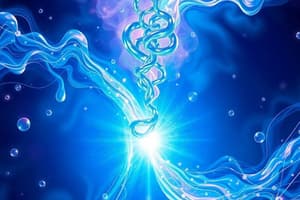Podcast
Questions and Answers
Describe reversible reactions such as the dehydration of hydrated copper(II) sulfate and the effect of heat on ammonium chloride.
Describe reversible reactions such as the dehydration of hydrated copper(II) sulfate and the effect of heat on ammonium chloride.
Reversible reactions are reactions that can proceed in both forward and reverse directions. The dehydration of hydrated copper(II) sulfate involves the removal of water molecules from the copper(II) sulfate crystals. When heated, ammonium chloride decomposes into ammonia gas and hydrogen chloride gas. These reactions are reversible because by applying the appropriate conditions (e.g., adding water or cooling the mixture) you can reverse the process and reform hydrated copper(II) sulfate or ammonium chloride.
Some reactions are reversible and this is indicated by the symbol '⇌' in equations.
Some reactions are reversible and this is indicated by the symbol '⇌' in equations.
True (A)
Describe a test for the presence of water using anhydrous copper(II) sulfate.
Describe a test for the presence of water using anhydrous copper(II) sulfate.
Anhydrous copper(II) sulfate is a white powder that turns blue in the presence of water. This is because the copper(II) sulfate absorbs water molecules to form hydrated copper(II) sulfate, which is blue. To test for the presence of water, you can add a small amount of anhydrous copper(II) sulfate to the sample. If the powder turns blue, then water is present.
Describe a physical test to show whether a sample of water is pure.
Describe a physical test to show whether a sample of water is pure.
A reversible reaction can reach dynamic equilibrium in a sealed container.
A reversible reaction can reach dynamic equilibrium in a sealed container.
What are the characteristics of a reaction at dynamic equilibrium? (Select all that apply)
What are the characteristics of a reaction at dynamic equilibrium? (Select all that apply)
Explain the effect of changing either temperature or pressure on the position of equilibrium in a reversible reaction.
Explain the effect of changing either temperature or pressure on the position of equilibrium in a reversible reaction.
References to Le Chatelier's principle are not required to understand why a catalyst does not affect the position of equilibrium in a reversible reaction.
References to Le Chatelier's principle are not required to understand why a catalyst does not affect the position of equilibrium in a reversible reaction.
What occurs when a reversible reaction reaches dynamic equilibrium?
What occurs when a reversible reaction reaches dynamic equilibrium?
How does an increase in temperature affect a reversible reaction at equilibrium?
How does an increase in temperature affect a reversible reaction at equilibrium?
Which statement accurately describes a characteristic of a catalyst in a reversible reaction?
Which statement accurately describes a characteristic of a catalyst in a reversible reaction?
What effect does an increase in pressure have on a reversible reaction that produces fewer moles of gas?
What effect does an increase in pressure have on a reversible reaction that produces fewer moles of gas?
Which of the following statements regarding dynamic equilibrium is incorrect?
Which of the following statements regarding dynamic equilibrium is incorrect?
Flashcards
Reversible reaction
Reversible reaction
A reaction that can proceed in both forward and reverse directions.
Dynamic equilibrium
Dynamic equilibrium
A state where the forward and reverse reactions occur at the same rate, and the concentrations of reactants and products remain constant.
Equilibrium symbol
Equilibrium symbol
The symbol $ ightleftharpoons$ indicating a reversible reaction.
Copper(II) sulfate test
Copper(II) sulfate test
Signup and view all the flashcards
Effect of heat on ammonium chloride
Effect of heat on ammonium chloride
Signup and view all the flashcards
Temperature shift
Temperature shift
Signup and view all the flashcards
Pressure shift
Pressure shift
Signup and view all the flashcards
Catalyst effect
Catalyst effect
Signup and view all the flashcards
Pure water test
Pure water test
Signup and view all the flashcards
Dehydration
Dehydration
Signup and view all the flashcards
Forward reaction
Forward reaction
Signup and view all the flashcards
Reverse reaction
Reverse reaction
Signup and view all the flashcards
Reaction rate
Reaction rate
Signup and view all the flashcards
Constant concentrations
Constant concentrations
Signup and view all the flashcards
Effect on reversible reactions
Effect on reversible reactions
Signup and view all the flashcards
Anhydrous copper(II) sulfate
Anhydrous copper(II) sulfate
Signup and view all the flashcards
Hydrated copper(II) sulfate
Hydrated copper(II) sulfate
Signup and view all the flashcards
Ammonium chloride
Ammonium chloride
Signup and view all the flashcards
Physical tests
Physical tests
Signup and view all the flashcards
Moles of gas
Moles of gas
Signup and view all the flashcards
Reversible Reaction
Reversible Reaction
Signup and view all the flashcards
Dynamic Equilibrium
Dynamic Equilibrium
Signup and view all the flashcards
Equilibrium Shift (Temperature)
Equilibrium Shift (Temperature)
Signup and view all the flashcards
Equilibrium Shift (Pressure)
Equilibrium Shift (Pressure)
Signup and view all the flashcards
Catalyst Effect on Equilibrium
Catalyst Effect on Equilibrium
Signup and view all the flashcards
Study Notes
Reversible Reactions and Equilibrium
- Reversible reactions are indicated by the symbol ⇌ in equations.
- Examples include the dehydration of hydrated copper(II) sulfate and the effect of heat on ammonium chloride.
- A test for water presence uses anhydrous copper(II) sulfate.
- A physical test determines if a sample of water is pure.
- Reversible reactions can reach dynamic equilibrium in a sealed container.
Characteristics of Dynamic Equilibrium
- The forward and reverse reactions occur at the same rate.
- Reactant and product concentrations remain constant.
Effect of Temperature and Pressure on Equilibrium
- Increasing or decreasing temperature shifts the equilibrium position towards the endothermic (or exothermic) reaction.
- Increasing or decreasing pressure shifts the equilibrium position towards the side with fewer or more moles of gas.
Catalyst Effect on Equilibrium
- A catalyst does not affect the equilibrium position of a reversible reaction.
Studying That Suits You
Use AI to generate personalized quizzes and flashcards to suit your learning preferences.




